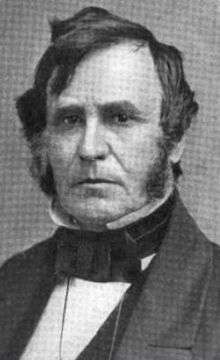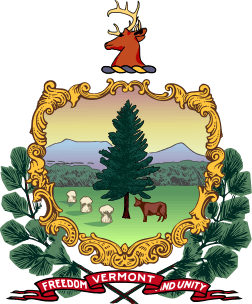Paul Dillingham
Paul Dillingham Jr. (August 10, 1799 – July 26, 1891) was an American lawyer and politician. He served as a U.S. Representative from Vermont, the 23rd Lieutenant Governor of Vermont from 1862 to 1865, and the 29th Governor of Vermont in 1865 and 1866.
Paul Dillingham Jr. | |
|---|---|
 | |
| 29th Governor of Vermont | |
| In office October 13, 1865 – October 13, 1867 | |
| Lieutenant | Abraham B. Gardner |
| Preceded by | J. Gregory Smith |
| Succeeded by | John B. Page |
| 23rd Lieutenant Governor of Vermont | |
| In office 1862–1865 | |
| Governor | J. Gregory Smith |
| Preceded by | Levi Underwood |
| Succeeded by | Abraham B. Gardner |
| Member of the U.S. House of Representatives from Vermont's 1st district | |
| In office March 4, 1843 – March 3, 1847 | |
| Preceded by | Augustus Young |
| Succeeded by | Lucius B. Peck |
| Member of the Vermont Senate | |
| In office 1841–1842 1861 | |
| Member of the Vermont House of Representatives | |
| In office 1833–1835 1837–1840 | |
| Personal details | |
| Born | August 10, 1799 Shutesbury, Massachusetts |
| Died | July 26, 1891 (aged 91) Waterbury, Vermont |
| Resting place | Village Cemetery, Waterbury, Vermont |
| Political party | Democratic Republican |
| Spouse(s) | Sarah Partridge Carpenter Dillingham Julia Carpenter Dillingham |
| Relations | William Paul Dillingham (son) Matthew H. Carpenter (son in law) |
| Children | 7, including William Paul Dillingham |
| Profession | Attorney |
Early life
Dillingham was born in Shutesbury, Massachusetts on August 10, 1799, a son of Paul Dillingham Sr. and Hannah (Smith) Dillingham.[1] The Dillingham family moved to Waterbury, Vermont in 1805, where Dillingham worked on the family farm and attended the district school in Waterbury and Montpelier's Washington County Grammar School.[1] In 1820, he commenced studying law in the office of Judge Daniel Carpenter.[1] He was admitted to the bar in March 1823, and in April he began to practice in Waterbury as Carpenter's partner.[1] He gained a reputation throughout Vermont as a skilled trial lawyer with a superior ability to present oral arguments to judges and juries.[1]
Early career
Entering politics as a Democrat, Dillingham served as a Waterbury justice of the peace from 1826 to 1844, and town clerk from 1829 to 1844.[1] He served as Waterbury's member of the Vermont House of Representatives from 1833 to 1835, as State's Attorney of Washington County from 1835 to 1838, and again as Waterbury's member of the Vermont House from 1837 to 1840.[1] Dillingham served as a delegate to the State constitutional convention of 1836, and a member of the Vermont State Senate in 1841 and 1842.[1]
Congressman
.jpg)
Dillingham was elected as a to the Twenty-eighth and Twenty-ninth Congresses (March 4, 1843 – March 3, 1847).[1] He was not a candidate for renomination in 1846.[1] During Dillingham's House service, he served on the Judiciary Committee and the Committee on Claims.[1] The only Democrat in Vermont's Congressional delegation, he favored the annexation of Texas and supported US involvement in the Mexican-American War.[1]
Dillingham was a delegate to the 1857 State constitutional convention.[2] In 1861, Dillingham served again in the Vermont Senate.[1]
Lieutenant governor
Increasingly opposed to slavery and secession, Dillingham declined the Democratic Party's 1860 nomination for governor.[2] When the American Civil War started, he officially changed his allegiance from Democratic to Republican.[1] He served as the 22nd Lieutenant Governor from 1862 to 1865.[1] Holding office at the height of the war, Dillingham's efforts were focused on aiding governors Frederick Holbrook and J. Gregory Smith to obtain passage of laws for raising, paying, and equipping soldiers for the Union Army.[1] In addition, he campaigned throughout Vermont for the Republican (Unionist) ticket of Abraham Lincoln and Andrew Johnson in the 1864 United States presidential election.[1]
Governor
Dillingham served as the 29th governor of Vermont from 1865 to 1866.[1] As governor, he created Vermont's first reform school and established Vermont's first normal school for teacher training (now Vermont Technical College).[1] It also fell to Dillingham to appoint two members of the U.S. Senate to replace senators who had died.[1] To succeed Jacob Collamer, Dillingham selected Luke P. Poland.[1] To replace Solomon Foot, Dillingham first offered the appointment to former governor J. Gregory Smith.[1] When Smith declined, Dillingham selected George F. Edmunds.[1]
Later life
He resumed the practice of law, and was a delegate to the State constitutional convention in 1870.[2] He retired in 1875.[2]
Death and burial
Dillingham died at his home in Waterbury on July 26, 1891.[1] He is interred in the Village Cemetery in Waterbury.[3]
Family
He married Sarah Partridge Carpenter, a daughter of Daniel Carpenter.[1] She died on September 20, 1831, and on September 5, 1832 Dillingham married Sarah's sister Julia.[1] He had seven children who lived to adulthood, including William Paul Dillingham, who served as governor and U.S. Senator.[1] Dillingham was also the father in law of Senator Matthew H. Carpenter.[4]
References
- "Hon. Paul Dillingham: The Venerable Ex-Governor Dead at the Age of Nearly 92 Years". The Cambridge Transcript. Cambridge, VT. August 7, 1891. p. 7 – via Newspapers.com.
- Duffy, John J.; Hand, Samuel B.; Orth, Ralph H. (2003). The Vermont Encyclopedia. Hanover, NH: University Press of New England. p. 106. ISBN 978-1-58465-086-7.
- US House and Senate Historians (2005). Biographical Directory of the United States Congress, 1774-2005. Washington, DC: US Government Printing Office. p. 961. ISBN 978-0-1607-3176-1.
- Haubrich, Paul (October 30, 2016). "Class of 1857: Matthew Hale Carpenter". Milwaukee Independent. Milwaukee, WI.
External links
- United States Congress. "Paul Dillingham (id: D000346)". Biographical Directory of the United States Congress.
- Paul Dillingham at The Political Graveyard
- Paul Dillingham at National Governors Association
- Paul Dillingham at Find a Grave
| Party political offices | ||
|---|---|---|
| Preceded by Nathan Smilie |
Democratic nominee for Governor of Vermont 1840 |
Succeeded by Nathan Smilie |
| Preceded by John Smith |
Democratic nominee for Governor of Vermont 1847, 1848 |
Succeeded by Jonas Clark |
| Preceded by J. Gregory Smith |
Republican nominee for Governor of Vermont 1865, 1866 |
Succeeded by John B. Page |
| U.S. House of Representatives | ||
| Preceded by Augustus Young |
Member of the U.S. House of Representatives from Vermont's 4th congressional district 1843–1847 |
Succeeded by Lucius B. Peck |
| Political offices | ||
| Preceded by Levi Underwood |
Lieutenant Governor of Vermont 1862–1865 |
Succeeded by Abraham B. Gardner |
| Preceded by J. Gregory Smith |
Governor of Vermont 1865–1867 |
Succeeded by John B. Page |
![]()
